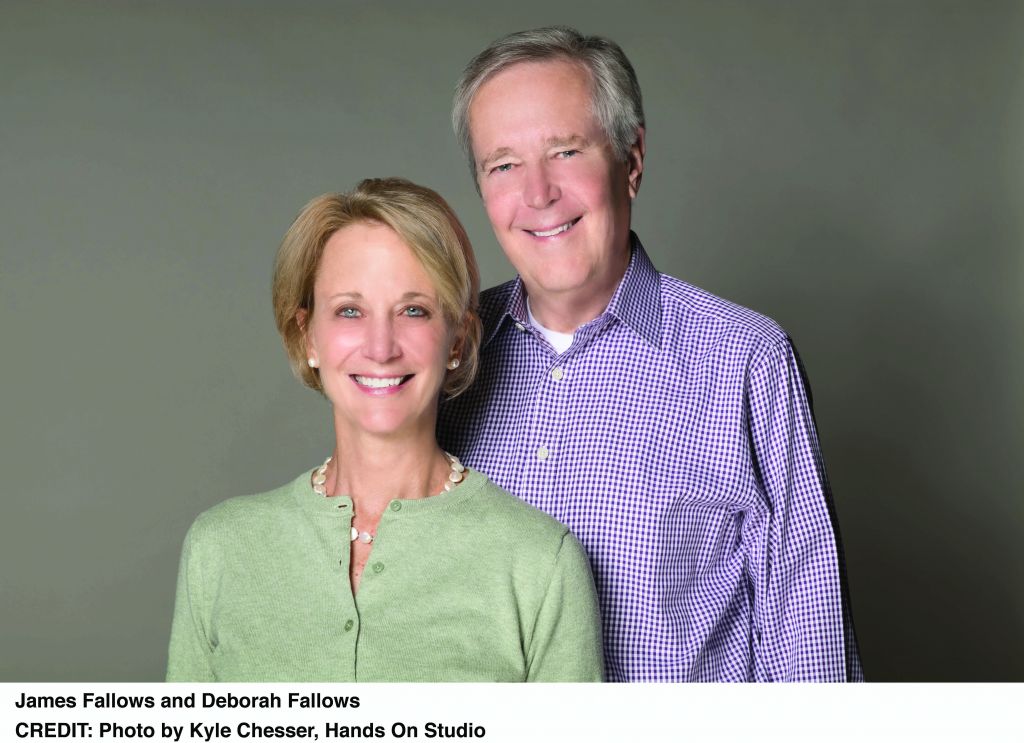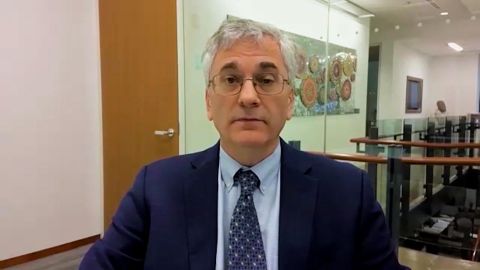James and Deborah Fallows traveled 100,000 miles across America. Here’s what they learned about “Our Towns”
Renowned writers James and Deborah Fallows are known to travel to places at the forefront of change. In their latest book, Our Towns, the couple details their “100,000 mile journey into the heart of America.” They found that Americans are more diverse than one can even imagine: over the course of nearly five years, the Fallows met people from all walks of life, with different values, jobs, backgrounds, and visions for the future. They spoke to local leaders, lifelong residents, and the next generation. Their observations of opportunity in these “towns on the rise” highlight the civic and economic reinvention taking place in these changing places.
We recently asked t he Fallows about their provocative takeaways from their epic journey crisscrossing “what the world considers second or third-tier locations” in America:
he Fallows about their provocative takeaways from their epic journey crisscrossing “what the world considers second or third-tier locations” in America:
- Chasing the Dream: What are the notable features or policies in these “towns on the rise” that struck you as the most vital?
James and Deborah Fallows: Of course the story varies city-by-city, and depending on the particular challenges and advantages a particular region or community faces. But in general we were increasingly struck by the importance of “local patriotism” in all its forms. That is: people who felt that they had a responsibility (and opportunity) to help create a community, rather than just to enjoy whatever amenities their predecessors had created. People who understood the “civic story” — the arc of economic and political history that had led to this moment’s predicament, and that offered possibilities for its next step. People who felt that their greatest satisfaction could come in trying to improve circumstances in the place they were from. The details vary, but the crucial common theme was people who thought they had a responsibility for the community beyond their own front door.
- How are geography and opportunity connected?
In a country as big and complex as the United States, contradictory realities are simultaneously true. In modern America, that means the simultaneous truths that: the biggest, richest, most dynamic cities continue to play a crucial, attractive role in business, culture, and finance — and also opportunities are diversifying, across the United States.
When younger people were able to make new opportunities away from the biggest cities — in Fresno, CA, or Columbus, OH, in Duluth, MN, or Allentown and Erie, PA — it was mainly through a combination of the connective tools that modern communications systems enable, and the opportunities that are best attuned to a particular geographic location. (For instance: in Fresno, capital of California’s agriculturally productive Central Valley, new opportunities in high-tech agriculture. In Duluth and Allentown, advanced-manufacturing businesses.)

- How do the public and private spheres seem to interact with each other in the communities you visited?
Probably the biggest, starkest difference between Washington DC, where we’re normally based, and many of the cities that we visited was the way in which the concept of “public-private partnerships” was understood. In Washington, I think the phrase is understood as one more aspect of public-affairs cynicism — a euphemism for ‘log-rolling’ or favor-trading. In many of the cities we visited, and often at the state level as well, it described something real — a coordinated effort of government, business, and non-profit entities to do something none of them could have achieved on its own. Simple illustration: the A.J. Whittenberg Elementary School of Engineering in Greenville, SC — where engineers from local factories, including those of GE and BMW, volunteer as teachers in a local public school to help young students, often from non-privileged backgrounds, understand engineering principles from the start of their education. We saw so many other illustrations, in so many places, that the abundance (and specificity) of private-public partnerships became one of our markers for overall civic success.
- How does “local patriotism” impact the re-invigoration of small towns?
The point may sound simple or obvious, but we ended up thinking that it made a huge difference whether citizens felt committed to creating the community where they lived, versus simply “consuming” it, by which I mean enjoying the features and amenities that their predecessors had worked to create. [And part of this answer is included in the first question, above.]
A “local patriot,” by this measure, is someone who thinks that his or her responsibilities, or even awareness, extend beyond their own front door — that their own satisfaction and achievement in life involves the longer-term welfare of the community as a whole. Sometimes these are people who grew up in a town and remember both its past strengths (like factories that have disappeared) and its past challenges (like a history of segregation). Sometimes they are people who “discovered” the town, by going there for a work assignment or for college, or marrying someone who had grown up there (a surprisingly common story for why people end up where they do). Sometimes they are people who arrived in a town accidentally and, on longer exposure, decided it was the place they wanted to be. The common theme in all these cases is people who end up feeling a long-term investment in the development of a certain area — as opposed to thinking that it’s just where they’ll live, until they decide to move someplace more interesting or attractive.
- What can larger cities learn from the successes and struggles of their smaller counterparts?
Some of today’s issues really do vary by the scale of the city involved, and so solutions that are practical in Sioux Falls or Allentown wouldn’t make any sense in San Francisco or Manhattan. Transportation and commuting issues are high on this list — smaller towns aren’t going to have subways — along with some of the intense gentrification problems that cities with very high concentrations of wealth, within limited physical space, are now dealing with. Seattle, San Francisco, New York, San Diego, and Boston of course exemplify this challenge.
Those differences are obvious. But in an impressively large realm of other urban-development issues, approaches that are devised and refined in one type of city, can also be relevant in other places that are either much larger or much smaller. For instance: developments in “career technical education,” which matches students whose parents might have worked in factories, with the new high-wage technical opportunities where the demand for skilled workers is very strong. We’ve seen examples of very similar programs in cities as large as Detroit and Los Angeles, and as small as St. Marys, in coastal Georgia. The practices and successful patterns of downtown revitalization efforts are also strikingly similar, in towns of 20,000 and those ten times that large. The concept of long-term public-private partnership is also independent of the specific size of a city. The civic role of libraries, and of public-art projects, also has more similarities than differences among very large and very small places.
So, while our project was consciously looking at towns and cities that were “small” in the sense of not being objects of regular media coverage, we very much feel as if there is a menu of approaches that can work for any city, and where large- and small-city leaders alike can share their experience and advice.
- In your book, you describe generational differences in attitudes about the economy. How might this impact opportunity and development in towns like the ones you visited?
The long pattern of American economic opportunity is that younger people have been more willing to shift location, and work plans, to adjust to the ever changing obstacles and possibilities, than people in middle age or beyond. To some degree this is pure common sense: in the 1800s, young men and women raised on the farm went off in search of factory or office jobs in the cities. (In the post-Civil War decades, most Americans worked on farms rather than in cities; now barely one percent of Americans are farmers, which suggests how many American families have been through this shift themselves.) Through the 1900s, many young people from small-town backgrounds left home for education, or the military — and never really returned to the little hamlets they still thought of as “back home. ” Meanwhile, people in their late 40s, 50s, and beyond are more likely to have felt “trapped” or “place-bound” when circumstances changed: as farming became more difficult, they were stil responsible for the family farm. As the coal-mining industry went into its decades-long decline as a job-creator (far more Americans worked as coal miners a century ago, during World War I, than do today), many older miners felt their only realistic option was to hang on, and hope they didn’t outlive their jobs and benefits. Their children were left with the choice of moving away, or staying in the tougher circumstances of post-coal-boom Appalachia.
The real point is: while the details of industrial disruption and dislocation change decade by decade — the auto industry booming in one era, collapsing in another — the main theme remains, of younger people being better able to make the necessary adjustments for a successful shift to a new economic landscape. (They can move to a different part of the country; study different subjects in school; adapt themselves emotionally to “what is ahead” rather than to “how things used to be.” ) And generally this is what we found around the country as well. The people most likely to sit in diners and lament what had been lost were people of an age actually to have lost things — retirees, or nearly so. The people of their children’s generation are more likely to be thinking of what’s ahead.
- How does the story of what’s going on in small towns across America differ from the overall national news coverage of them?
The main difference is what I think of as dimensionality. Even the best-intentioned and highest quality national-news presentations of places between the coasts tend to treat their citizens as objects. They’re responding to trends that originate elsewhere. (“Do Trump voters in Ohio still like Trump?”) They’re illustrating the local effects of global trends. (“Tariffs disrupt factory life in the heartland.”) They’re responding to the brand messages and themes of each new wave of political candidates. (“Are Iowa voters ready for another woman?”) And of course they can enter the news as victims of disasters — hurricanes, floods, drought, fires, mass shootings.
Without anyone consciously planning it this way, smaller-town Americans are often presented as people things happen to. Two-dimensional figures. As opposed to people who are in many cases making things happen — for their families, their communities, themselves. [Of course of course, there are trends bigger than any individual can cope with, from Dust Bowl drought to the financial crash of 2008. My point is that we saw more “agency” in smaller-town life than the national media generally convey.]
- What surprised you most?
How endlessly interesting it has been to hear people talk about their own communities, and what plans and dreams they have in mind. To put it another way: How much the smaller-town America we saw differs from the famed Saul Steinberg New Yorker cover-painting of decades ago, with the hazy vagueness of interior America. I loved that painting, but also loved discovering its antithesis.



